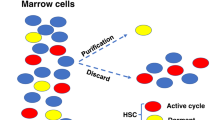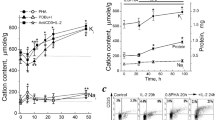Abstract
HARRIS'S experiments1,2 have shown that about the 14th day after whole-body γ-irradiation of young male guinea pigs the marrow is considerable simplified in the types of cells which it contains. At this time an accumulation of round cells was noted in the marrow. This accumulation preceded a rapid regeneration of proerythroblasts and myeloblasts. The round cells were of two types: (1) small cells which, morphologically, closely resemble small lymphocytes in smear preparations of lymphoid tissue; (2) cells intermediate in appearance and size between small lymphocytes and blast cells. A characteristic of the intermediate cells is the high ratio between nucleus and cytoplasm. On staining with MacNeal's tetrachrome, the nuclear chromatin has a relatively uniform appearance. In some cells the cytoplasm appears to be minimal whilst in others it is located in a well-defined nuclear hof. Apart from their morphology, certain findings in these experiments suggested the possibility that the intermediate cells might be considered as early free stem-cells. These are: (1) their quantitative relation to blast cells in the marrow of control animals; their total number is about 20 per cent less than the combined numbers of proerythroblasts and myeloblasts, and conforms to the quantitative finding in normal marrow that the more immature cells are comparatively few in number; (2) quantitative studies show that these cells are even more radiosensitive than myeloblasts and proerythroblasts; (3) mitotic figures were seen in cells of their size, shape and cytoplasmic content; and (4) considerable numbers of these cells preceded a rapid regeneration of myeloblasts and proerythroblasts.
This is a preview of subscription content, access via your institution
Access options
Subscribe to this journal
Receive 51 print issues and online access
$199.00 per year
only $3.90 per issue
Buy this article
- Purchase on Springer Link
- Instant access to full article PDF
Prices may be subject to local taxes which are calculated during checkout
Similar content being viewed by others
References
Harris, P. F., Brit. Med. J., 2, 1032 (1956).
Harris, P. F., Brit. J. Exp. Path., 39, 557 (1958).
Lajtha, L. G., Oliver, R., and Ellis, F., in “Advances in Radiobiology”, edit. by de Hevesy, G. C., Forssberg, A. G., and Abbatt, J. D., 54 (Oliver and Boyd, Edinburgh and London, 1957).
Bond, V. P., Fliedner, T. M., Cronkite, E. P., Rubini, J. R., Brecher, G., and Schork, P. K., Acta Haemat., 21, 1 (1959).
Pelc, S. R., and Glucksman, A., Exp. Cell. Res., 8, 336 (1955).
Gowans, J. L., J. Physiol., 146, 54 (1959).
Yoffey, J. M., Everett, N. B., and Reinhardt, W. O., Nature, 182, 1608 (1958).
Author information
Authors and Affiliations
Rights and permissions
About this article
Cite this article
HARRIS, P., KUGLER, J. Cells which Synthesize Deoxyribonucleic Acid in Guinea Pig Bone Marrow During Recovery from Whole-Body γ-Irradiation. Nature 184, 1883–1884 (1959). https://doi.org/10.1038/1841883a0
Issue Date:
DOI: https://doi.org/10.1038/1841883a0
Comments
By submitting a comment you agree to abide by our Terms and Community Guidelines. If you find something abusive or that does not comply with our terms or guidelines please flag it as inappropriate.



